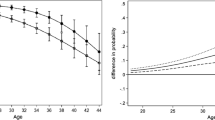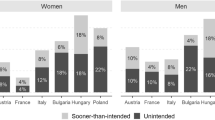Abstract
The aim of this article is to examine the determinants of couples’ childbearing intentions, by explicitly taking into account the agreement or disagreement of the two members of the couple. The relevance of the partner’s reproductive intentions has been well recognised in the literature, but few studies have provided in-depth analyses of the fertility plans of both partners. In our study, we used the household-level data from a survey on “Family and Social Subjects”, carried out by the Italian National Statistical Office in 2003, which provides characteristics on both partners. We adopted a couple’s perspective which allows us to give a unitary picture of the concordant or discordant nature of partners’ first child intentions. We found that a lack of agreement in the reproductive decision-making process is likely to occur in the Italian couples where the role of the woman is less traditional. In particular, cohabitant, highly educated and working women are more likely to be in disagreement with their partners in the decisions concerning having a first child. Being religious may be also a source of discordance in the couples’ reproductive plans. Our findings support the utility of taking a couple-based approach in studies on fertility intentions.
Résumé
Le but de cet article est d’examiner les déterminants des intentions de fécondité, en prenant en compte de façon explicite la concordance ou la discordance au sein des couples. La pertinence des intentions de fécondité du partenaire est bien établie dans la littérature, mais à ce jour peu d’analyses approfondies des intentions des deux partenaires ont été réalisées. Nous avons exploité les données des ménages dans l’enquête Family and Social Subjects (famille et sujets sociaux) menée par l’Institut national de la statistique en Italie en 2003, qui renseigne les caractéristiques des deux partenaires. La perspective adoptée est celle du couple, ce qui a permis de fournir une vision unifiée des intentions concordantes ou discordantes au sein du couple. Il apparaît qu’un désaccord au sein des couples en Italie est à même de se produire lorsque le rôle de la femme est moins traditionnel. En particulier, les femmes cohabitantes, très instruites et actives sont celles qui ont la probabilité la plus forte d’être en désaccord avec leur partenaire concernant les décisions d’avoir un premier enfant. La religiosité peut également être associée à des désaccords en matière d’intentions de fécondité. Nos résultats mettent en lumière tout l’intérêt de la prise en compte des deux membres du couple dans les études des intentions de fécondité.
Similar content being viewed by others
Notes
We also considered an alternative strategy: we applied a multinomial logistic model where the dependent variable has four categories that correspond to the four different combinations of his and her fertility intentions (“Both don’t intend”, “She intends, he doesn’t”, “He intends, she doesn’t”, “both partners intend”). The findings obtained with this model are consistent with those shown in Table 3. The complete results can be provided by the Authors on request.
References
Ajzen, I. (1985). From intentions to action: A theory of planned behavior. In J. Kuhl & J. Beckman (Eds.), Action control: From cognition to behavior (pp. 11–39). Heidelberg: Springer.
Ajzen, I. (1991). The theory of planned behavior. Organizational Behavior and Human Decision Processes, 50, 179–211.
Beckman, L. J. (1983). Communication, power, and the influence of social networks in couple decisions on fertility. In R. A. Bulatao & R. D. Lee (Eds.), Determinants of fertility in developing countries (Vol. 2, pp. 415–443). New York: Academic Press.
Beckman, L. J. (1984). Husbands’ and wives’ relative influence on fertility decisions and outcomes. Population and Environment: Behavioral and Social Issues, 7, 182–197.
Berrington, A. (2004). Perpetual postponers? Women’s men’s and couple’s fertilità intentions and subsequent fertility behaviour. Population Trends, 117, 9–19.
Billari, F., & Rosina, A. (2004). Italian ‘latest-late’ transition to adulthood and the consequences on fertility. Genus, LX(1), 71–87.
Bimbi, F. (1996). Differenze di genere nelle decisioni di procreazione. Inchiesta, 111, 15–22.
Bongaarts, J. (2001). Fertility and reproductive preferences in post-transitional societies, global fertility transition. Supplement to Population and Development Review, 27, 260–281.
Brewster, K. L., & Rindfuss, L. (2000). Fertility and women employment in industrialized countries. Annual Review of Sociology, 26, 271–287.
Corijin, M., Liefbroer, A. C., & De Jong Gierveld, J. (1996). It takes two to tango, doesn’t it? The influence of couple characteristics on the timing of the birth of the first child. Journal of Marriage and the Family, 58, 117–126.
Dalla Zuanna, G., & Tanturri, M. L. (2007). Veneti che cambiano 1971–2021 La popolazione sotto la lente di quattro censimenti. Verona (Italy): Edizioni CIERRE.
Del Boca, D., Pasqua, S., & Pronzato, C. (2004). Why are fertility and women’s employment rates so low in Italy? Lessons from France and the UK, IZA Discussion Papers 1274, Institute for the Study of Labor (IZA).
Di Giulio, P., & Rosina, A. (2007). Intergenerational family ties and the diffusion of cohabitation in Italy. Demographic Research, 16, 14.
Fraboni, R. (2005). Sposarsi. In A. Rosina & L. L. Sabbadini (Eds.), Diventare padri in Italia Fecondità e figli secondo un approccio di genere. Istat, Roma: Serie Argomenti.
Frejka, T. (2008). Parity distribution and completed family size in Europe: Incipient decline of the two-child family model? Demographic Research, 19(4), 47–72.
Fried, E. S., Hofferth, S. L., & Udry, J. R. (1980). Parity-specific and two-sex utility models of reproductive intentions. Demography, 17(1), 1–11.
Fried, E. S., & Udry, J. R. (1979). Wives’ and husbands’ expected costs and benefits of childbearing predictors of pregnancy. Social Biology, 26, 256–274.
Hill, R., Stycos, J. M., & Back, K. W. (1959). The family and population control. Chapel Hill: University of North Carolina Press.
ISTAT. (2006). La vita di coppia. Informazioni, 23, 1–134.
Jansen, M., & Liefbroer, A. C. (2006). Couple’s attitudes, childbirth, and the division of labor. Journal of Family Issues, 27(11), 1487–1511.
Kiernan, K. (2002). Cohabitation in Western Europe: Trends, issues and implications. In: A. Booth & A. Crouter (Eds.), Just living together: Implications of cohabitation on families, children and social policy (pp. 3–31). Hillsdale, NJ: Erlbaum.
Lesthaeghe, R. (1995). The second demographic transition in Western countries: An interpretation. In K. O. Mason & A. M. Jensen (Eds.), Gender and family change in industrialized countries (pp. 17–62). Oxford: Clarendon Press.
Lundberg, S., & Pollak, R. A. (2007). The American family and family economics. In National Bureau of Economic Research, Working Paper 12908.
MacDonald, P. (2006). Low fertility and the state: The efficacy of policy. Population and Development Review, 32(3), 485–510.
Mencarini, L., & Tanturri, M. L. (2004). Time use, family role-set and childbearing among Italian working women. Genus, special issue on Low fertility in Italy, XL(1), 111–137.
Miller, W. B., & Pasta, D. J. (1994). The psychology of child timing: A measurement instrument and a model. Journal of Applied Social Psychology, 24(3), 218–250.
Miller, W. B., & Pasta, D. J. (1995). Behavioural intentions: Which ones predict fertility behaviour in married couples? Journal of Applied Social Psychology, 25, 530–555.
Miller, T. B., & Short, S. E. (2004). Second births and the second shift: A research note on gender equity and fertility. Population and development Review, 30(1), 109–130.
Mills, M., Mencarini, L., Tanturri, M. L., & Bengall, K. (2008). Gender equity and fertility intentions in Italy and the Netherlands. Demographic Research, 18, 1–26.
Morgan, S. P. (1985). Individual and couple intentions for more children: A research note. Demography, 22(1), 125–132.
Namboodiri, K. (1983). Sequential fertility decision making and the life course. In R. A. Bulatao & R. D. Lee (Eds.), Determinants of fertility in developing countries (Vol. 2). Academic Press: New York.
Olah, L. S. (2003). Gendering fertility: Second births in Sweden and Hungary. Population Research and Policy Review, 22, 171–200.
Pinnelli, A. (1995). Women’s condition, low fertility, and emerging union patterns in Europe. In K. O. Mason & A. M. Jensen (Eds.), Gender and family change in industrialized societies. Oxford: Clarendon Press.
Rindfuss, R. R., Morgan, P. S., & Swicegood, G. (1988). First births in America: Changes in the timing of parenthood. Berkeley and Los Angeles: University of California Press.
Rosina, A. (2004). Family formation in Italy: A cohort approach. In G. Dalla Zuanna & G. A. Micheli (Eds.), Strong family and low fertility: A paradox?. Dordrecht: Kluwer Academic Press.
Saraceno, C. (1994). The ambivalent familism of Italian welfare state. Social Politics, 1, 60–82.
Schoen, R., Young, J. K., Nathanson, C. A., Fields, J., & Astone, N. M. (1997). Why do Americans want children? Population and Development Review, 23(2), 333–358.
Sevilla-Sanz, A. (2005). Social effects, household time allocation, and the decline in union formation. In Congressional Budget Office Working Paper No. 7.
Sobotka, T., & Testa, M. R. (2008). Attitudes and intentions toward childlessness in Europe. In C. Höhn, D. Avramov, & I. Kotowska (Eds.), People, population change and policies: Lessons from the population policy acceptance study (Vol. 1, pp. 177–211). Berlin: Springer.
Testa, M. R. (2006). Childbearing preferences and family issues in Europe. In Special Eurobarometer 253/Wave 65.1—TNS Opinion & Social, European Commission.
Testa, M. R., Lo Conte, M., & Prati, S. (2006). Second birth intentions and employment conditions in Italy. Paper presented at the European Population Conference, Liverpool.
Testa, M. R., & Toulemon, L. (2006). Family formation in France: Individual preferences and subsequent outcomes. Vienna Yearbook of Population Research, 2006, 41–75.
Thomson, E. (1997). Couple childbearing desires, intentions and births. Demography, 34(3), 343–354.
Thomson, E., & Hoem, J. (1998). Couple childbearing plans and births in Sweden. Demography, 35(3), 315–322.
Thomson, E., McDonald, E., & Bumpass, L. L. (1990). Fertility desires and fertility: Hers, his, theirs. Demography, 27, 579–588.
Townes, B. D., Beach, L. R., Campbell, F. L., & Wood, R. L. (1980). Family building: A social psychological study of fertility decisions. Population and Environment, 3(3–4), 210–220.
Van de Kaa, D. J. (1987). Europe’s second demographic transition. Population Bulletin, 42(1), 1–59.
Acknowledgements
Paper prepared within the project ‘Fertility Intentions and outcomes: The Role of Policies to Close the Gap’, was funded by the European Commission, DG Employment, Social Affairs and Equal Opportunities (Contract No. VS/2006/0685).
Author information
Authors and Affiliations
Corresponding author
Rights and permissions
About this article
Cite this article
Rosina, A., Testa, M.R. Couples’ First Child Intentions and Disagreement: An Analysis of the Italian Case. Eur J Population 25, 487–502 (2009). https://doi.org/10.1007/s10680-009-9188-8
Received:
Accepted:
Published:
Issue Date:
DOI: https://doi.org/10.1007/s10680-009-9188-8
Keywords
- Fertility intentions
- Couple’s reproductive decisions
- Partners’ disagreement in first childbearing
- Fertility decision-making process




